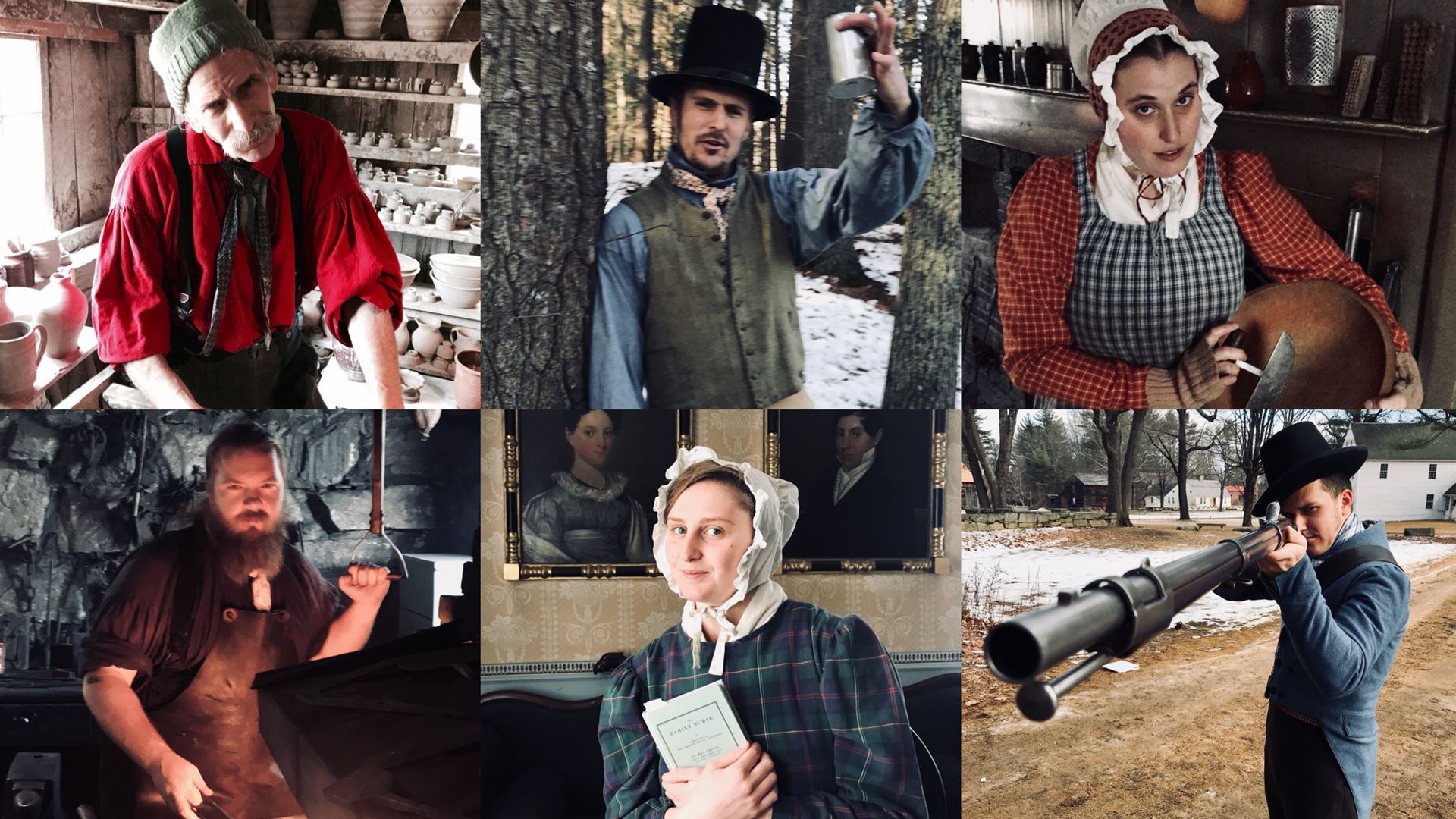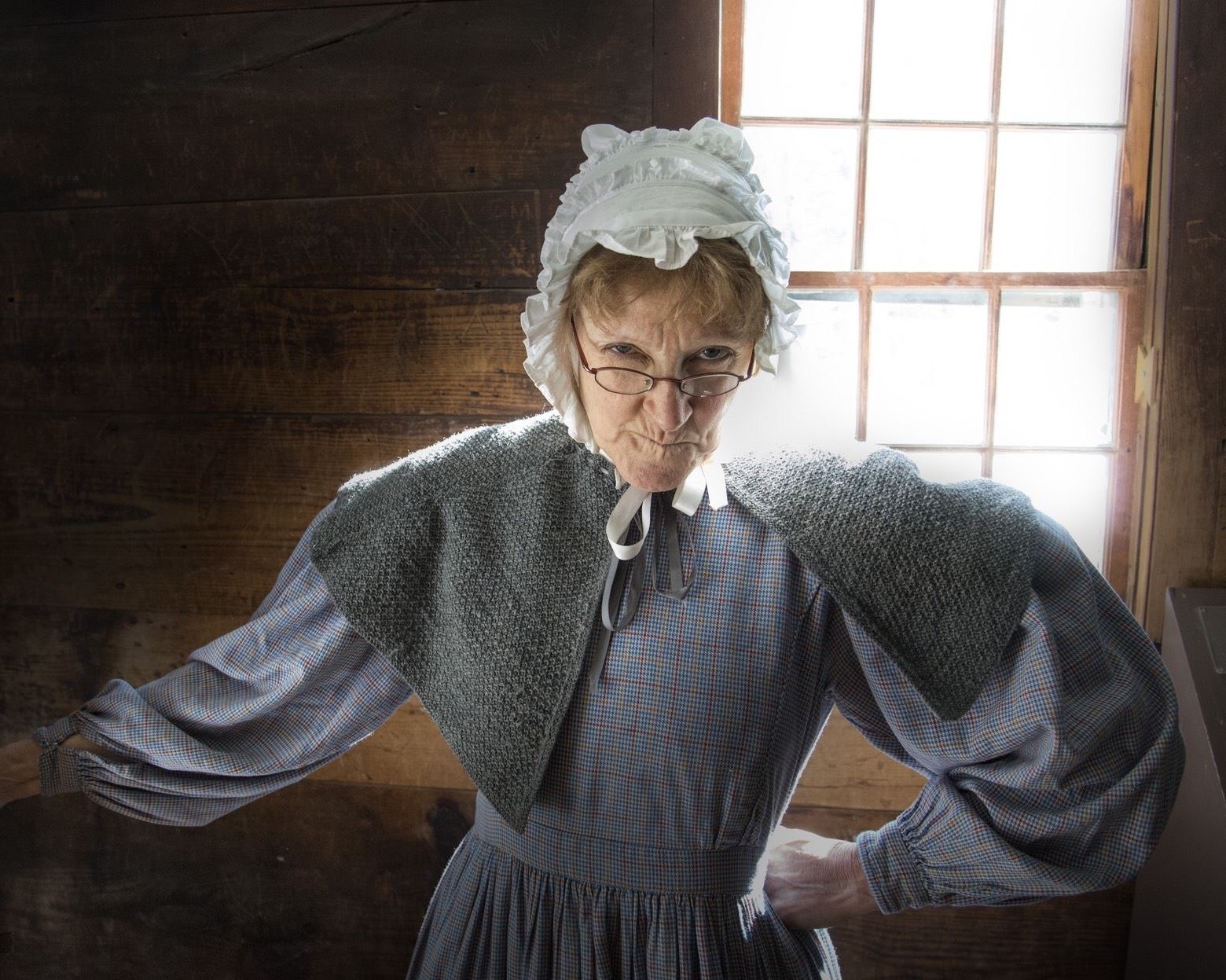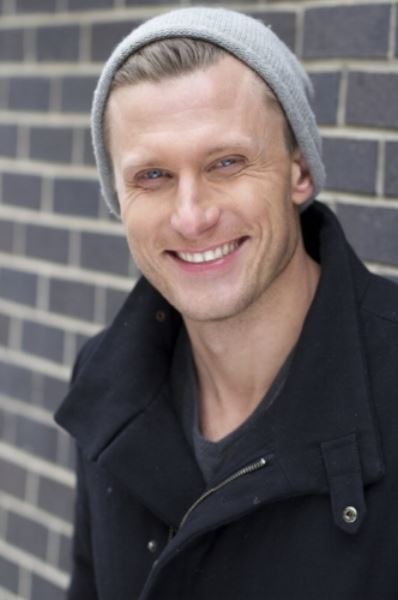
An Immersive Journey with the
Characters of Old Sturbridge Village
By Ilana Gustafson, Insights Editor
The winner of this year’s Lipsky Award for Excellence in Playwriting is P.J. Griffith for his epic immersive show, Midwinter Mischief. This script, created for the Old Sturbridge Village, is written entirely in Anapestic Tetrameter. It’s a playful and interactive show where the guests follow a scheming peddler on a mile-long journey through a 19th century village where they meet a cast of colorful, historically-based characters. It’s an ambitious undertaking that is accomplished with thoughtful skill and reverence to historical accuracy. I had a chance to email with P.J. to find out more about the process for creating his masterful story.
Can you tell us a little bit about yourself? How did your life path lead you to your current role as a script writer for Old Sturbridge Village?
I am an actor with a passion for working in immersive, site-specific theater. Beyond being in American Idiot on Broadway, I was in the immersive theatrical project Sleep No More at The McKittrick Hotel, helped create the For the Record series in Los Angeles as well as Shaken Not Stirred in NYC.
I have been going to OSV since I was a kid, having grown up in central Connecticut, and was cast as “Brom Bones” in the immersive Sleepy Hollow Experience that utilized OSV at night in fall 2016. During the day, I spent a lot of time walking the museum, soaking in as much information/interesting stories about the time period as possible. Midwinter Mischief took shape after hours of conversations with the historical interpreters who inhabit the village on a daily basis. It was the product of my curiosity and fascination with the strange, unknown specifics of daily life in early America.
What was the script development process for Midwinter Mischief from inception to performance? Was it a collaborative process with the performers or did they get a fully developed script before going into rehearsals?
I was tasked with distilling the winter experience at OSV into a two- hour adventure where guests could emotionally connect to the content and collections of the museum. It was an exciting and well-supported task as I was given pretty much free reign of the village‘s resources—from its costumes to its historical buildings to its arms collection to its culinary staff to its animals.
I wrote a full script over the course of a few months and sent it out to the heads of each department, who willingly picked it apart like 5 dramaturgs, punching holes in any plot-lines or language that were not true to 1830’s rural New England. After a few more drafts, it was handed out to the 30+ historical interpreters who would be playing the roles in it. Some were nervous because they weren’t used to memorizing text or speaking in verse, others jumped in with unbridled excitement. Everyone had their input and we developed each scene over a few weeks of rehearsals so it t well in each of the 13 spaces and made sense coming out of the mouths of each character.
 What is the thought behind the choice to write the script entirely in verse? Midwinter Mischief is a fable written in Anapestic Tetrameter—a style made popular by Edgar Allan Poe, Clement Clarke Moore and Lord Byron in the first half of the 19th century. I thought it would be an interesting way to tell stories in a poetic form that would grab the audience’s attention immediately and pull them out of their day-to-day reality, spending of their disbelief into a different world.
What is the thought behind the choice to write the script entirely in verse? Midwinter Mischief is a fable written in Anapestic Tetrameter—a style made popular by Edgar Allan Poe, Clement Clarke Moore and Lord Byron in the first half of the 19th century. I thought it would be an interesting way to tell stories in a poetic form that would grab the audience’s attention immediately and pull them out of their day-to-day reality, spending of their disbelief into a different world.
How has it been received by the guests of OSV?
They have really loved it—from young kids through the older members of the museum. I tried to appeal to all of their senses on a cold winter’s afternoon. It was a piece that was driven by curiosity of what might be lurking around the next turn and tries to overwhelm their senses, not just listening to stories seeing scenes play out, but asking the audience to touch, taste, smell and feel winter in 1830s New England.
The audience was always one step behind a wily peddler who is bartering and scheming his way through the village to pay o his tab to the tavern keeper. I think everyone in that part of the world could relate to an underdog hustling to pay the bills. The experience also ended with a huge party in the tavern after finally catching up with the peddler, complete with period food, booze and live music.
You ask some lucky guests to play characters in the performance. I’m curious how guests respond?
Guests were given very specific characters when they arrive at Bullard Tavern. These “mischievous” characters all could have been drinking at the tavern in the 1830s, from John C. Colt (a notorious rake and brother to industrialist Samuel Colt, whom Edgar Allan Poe wrote a short story about) to Prudence Crandall (a Connecticut abolitionist who opened a controversial school for African-American girls).
Throughout the 2-hour adventure, guests were called by name and asked to take on tasks in different scenes, from throwing clay to dipping candles to stuffing a sausage to helping work a two-handed saw. Most loved it and dove in head-first. If they were too intimidated to get their hands dirty, they quickly convinced someone else in their party to cover them.
I love how the interpretation of the village and 19th century life is carried by the story. What do you believe to be the value for guests experiencing history in this way?
I think it gives guests a good feeling of where a lot of principals of our modern life began—a lot of luxuries and technology we take for granted in 2018 evolved from desire to solve problems in the early 19th century. Refrigeration, sanitation, medication, heating, the industrial process, the modern educational process and nationalism all have roots in that era.
What have been some of the challenges and triumphs of the show?
The weather became a challenging element. Volatile New England January and February could sometimes be too cold or too warm for an experience that was both in and out doors.
In one scene we utilized adorable baby oxen as a major plot point, but they could be REALLY fussy, especially when they sensed it was lunchtime. We had no real idea what this show would feel like over a stage that spanned over a mile until we put an audience into it. We adapted and evolved as we learned. The whole piece was like a giant clock with each gear dependent on the one it was connected to working. We played with the timing of each piece and the movement of the audience to make sure it went as smoothly as possible throughout the day. We staged the experience again in early 2018, learning from audience feedback of what they liked and what felt like it was a little too much. We had to cut the baby oxen and replaced them with a musket-firing scene.
In general, what are your thoughts on how theatre can help people connect to history?
I think theatre is a great opportunity to give people an emotional connection to history. History is just an interconnected web of people’s individual stories that are far more interesting than just memorized dates, locations and outcomes. By taking away the “imposed reverence” of “Historical Figures” out and looking at them as real human beings making difficult choices, there always seem to be parallels with what we read in the news and what any given person is dealing with on any given day. It is evident, now more than ever, that history has a tendency to repeat itself.
What other projects do you have on the horizon?
I’m currently in rehearsals for the world premiere of a new musical about “The Five Points” in NYC during the “draft riots“ of the 1860s called Paradise Square that will be making its world premiere at Berkeley Repertory Theater later this year. I’m also in talks for a new projects with Colonial Williamsburg in Virginia and the Cheney Homestead in Connecticut. I am always looking for interesting new spaces to tell interesting new stories in... 
This article can be found in Summer 2018 - "Lighting the Spark, Feeding the Flame" (Volume 28, Issue 3) of IMTAL Insights.

MEET THE LIPSKY WINNER:
P.J. Griffith is a writer/director/performer from New York City with an extensive background in theater and television, working on both sides of the proverbial camera. He specializes in creating site-specific, immersive theatrical experiences. As an actor, P.J. first gained experience in “immersive theater” playing principal roles in some of the country’s most critically-acclaimed and financially-successful immersive productions, including Sleep No More and Bond: Shaken Not Stirred in New York City, For the Record: Baz Luhrmann in Los Angeles, Descent in Sarasota and The Sleepy Hollow Experience in Massachusetts. P.J.’s other recent theater credits include “St. Jimmy” in American Idiot on Broadway, “Leon Czolgoscz” in Assassins at Yale Repertory Theater and “Jett Rink” in The Public Theater’s premiere of Giant. P.J. received the 2010 Los Angeles Drama Critics Circle Award for Best Featured Performance for Set-Up & Punch at The Blank Theater and the 2017 New York Musical Theater Festival Award for Outstanding Lead Performance for Georama. He can be seen on television in guest starring in roles in episodes of Blue Bloods, Gotham, Jessica Jones, The Good Wife, The Mysteries of Laura and Without a Trace, as well as in the feature films Easter Mysteries and The Dark Knight Rises. He has worked on the production staff Comedy Central Presents, Phenomenon, MADtv and VH1 Storytellers.